×
Save 20% On Your Purchase!
Use code SAVE20 at checkout to save on your purchase today from my Herbal Shop!
×
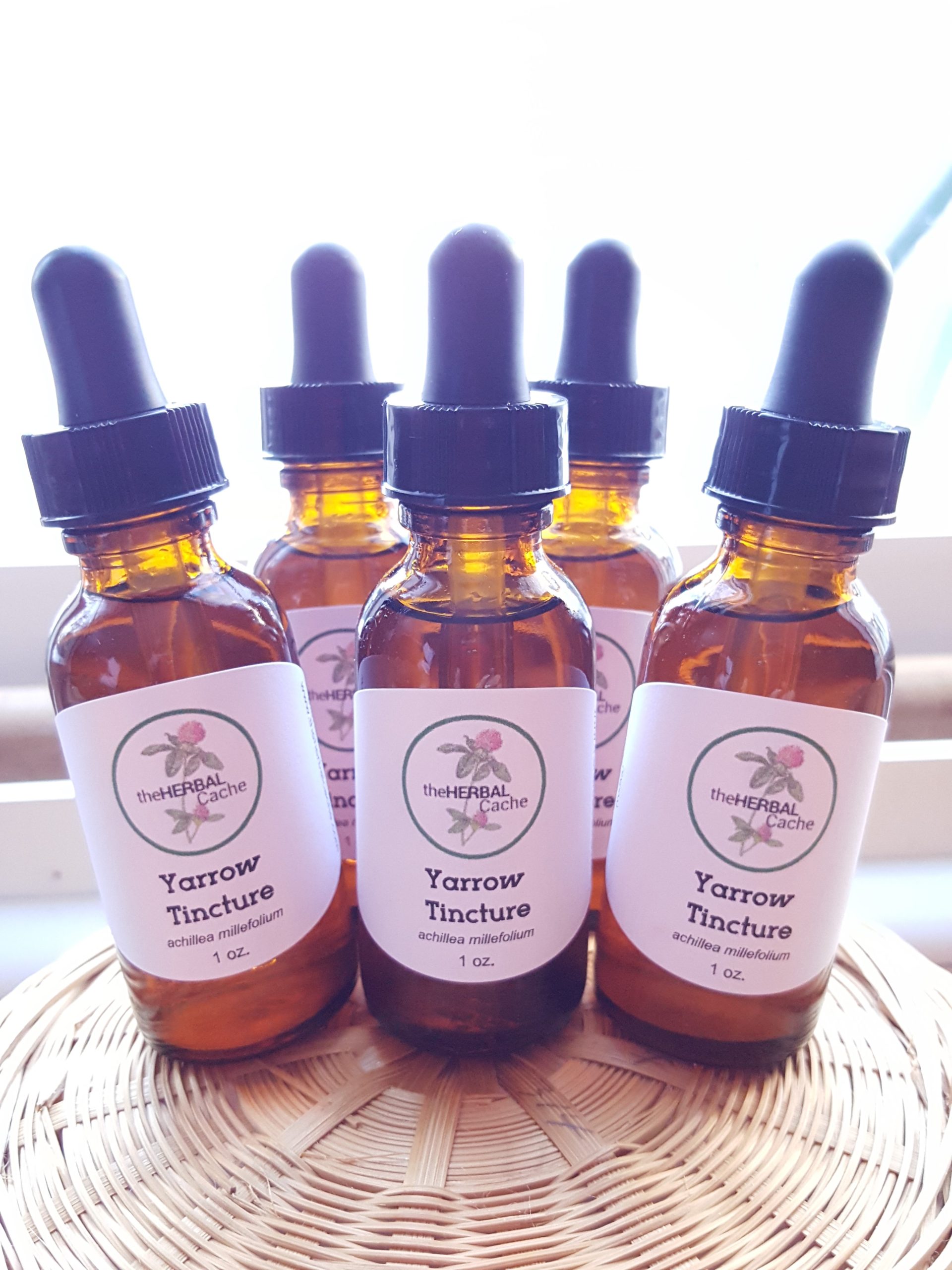
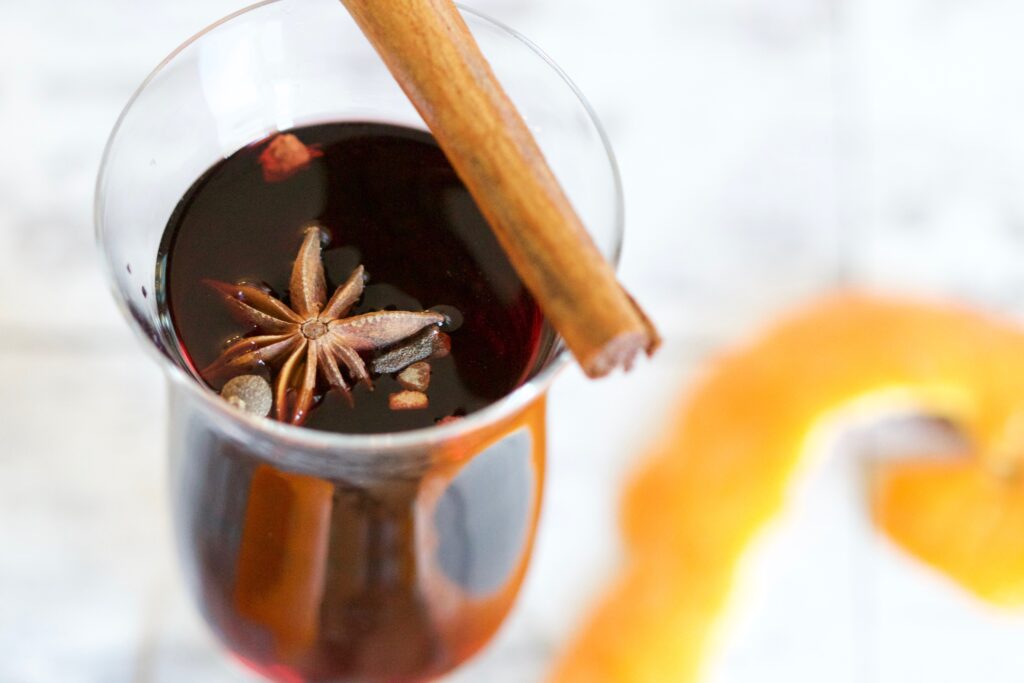
The simple definition of what a mulled wine is, is taking red wine, heating it up and adding spices to it.
But as we all know, we like to “spice” things up and create something with a little more pizzaz. And so the creation of a multitude of mulled wine styles begins.
Variations include adding spices, such as cinnamon, cloves, allspice, anise, and nutmeg. Citrus fruits and raisins can also be added to the mixture to enhance its flavor. And don’t forget other liquors, such as brandy, bourbon and beer are added depending on the recipe.
And there are many more cultures and countries that have some sort of mulled wine.
Mulled wine has a long history, starting back in 20 AD with the Romans.
By the 12th century, forms of mulled wine were very common in parts of Europe, especially in France and Spain. Recipes for this “spicy wine” can be found in written works of the time, like Regiment of Sanitat, written by Arnaud de Villeneuve, a doctor and theologian of the time.
This drink became even more popular in the 13th century, spreading further throughout Europe. The English king, Henry III, was very fond of mulled wine and made sure it was at the table when eating.
As the years went by, mulling was used more as a way to prevent waste of any wine that may have been unpleasant to taste. By adding herbs, spices and fruits, it made the wine more palatable.
Throughout the years, cultures took the recipes and altered them to suit their own taste. By adding different spices, herbs and fruits, they all created unique versions of this winter beverage.

In the Middle Ages, people viewed mulled wine as almost medicinal. They believed that the added spices made them healthier. They weren’t exactly wrong. And, alcohol was at times safer than the water that was readily available to those that lived in cities, especially during the Black Death.
Ancient Greece used spiced wine as a medicinal tonic for warming the body. The Greeks called this elixir hippocras, after Hippocrates of Kos, the physician known as the “father of medicine”.
When taking a dive into the ingredients, one can see how mulled wine is a form of medicine and the health benefits it can provide.
Red wine offers many health benefits. It supports cardiovascular health and helps fight inflammation. Because it contains resveratrol, it can help sharpen your mind and fights off free radicals. Red wine may also help to improve your mood.
A study, conducted at Curtin University in Australia, found that regular consumption of red wine reduced the risk of developing cardiovascular disease by lowering LDL cholesterol levels in postmenopausal women by 8 percent and increased HDL cholesterol levels by 17 percent.
When used as a sweetner, honey has many benefits. It is a natural antibiotic and helps to activate the medicinal properties of the other herbs and spices.
Cinnamon brings warmth into the digestive organs and extremities. It also helps to lowers blood sugar levels and helps remove digestive parasites.
Orange peel, which is high in vitamin C, can improve our immune system. You can learn more about the health benefits of orange in my blog post 21 Reasons to Get Orange Peel Into Your Diet.
Cloves are anti-parasitic and help remove worms from the gut and improve circulation. But don’t add too many or you will numb your taste buds.
Cardamom brings strength to the digestive tract.
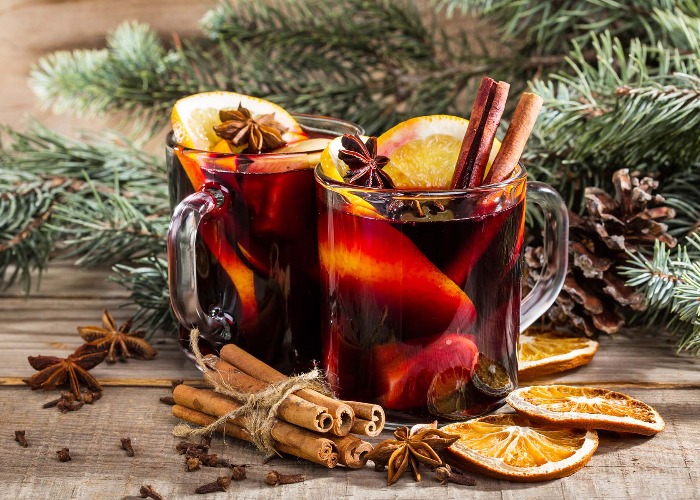
So why is mulled wine such a popular drink during the holidays and at Christmas?
This tradition appeared in the 1890’s, when outside German markets offered this warming beverage to their shoppers. Within a few years, it became a contest as to who could create the best tasting mulled wine in the market.
Charles Dickens, the writer, included a passage which mentioned Smoking Bishop, a popular mulled wine of the day, in his classic A Christmas Carol.
And what do you eat with mulled wine? There is nothing better to serve it with than shortbread, speculoos, or a cinnamon or almond cake.
Even though this is considered a holiday drink, Mulled Wine Day is celebrated on March 3.
There are a lot of variations when it comes to the recipes and ingredients for mulled wine. But here is a list of the most common items needed in making this beverage.
There is no shortage of recipes for mulled wine. Just Google it and see how many pages of recipes pop up. It’s really no surprise since this beverage has been around for centuries.
Once you start looking, you’ll be amazed at the variety of recipes that are out there. What is even more amazing is that once you know how to do it, you can start creating your own versions of mulled wine. There really is no wrong way.
To get you started, I put in a few links to some tasty mulled wines below. Once you try one, let me know what you think in the comments below.
CHEERS!
https://www.myrecipes.com/how-to/cooking-questions/what-is-mulled-wine
What is Mulled Wine? How to Make it and 5 Easy Recipes.
The mulled wine: origins and preparation advice
The History of Mulled Wine
https://www.nenaturalhealthcentre.com/uploads/2/5/8/6/25863178/mulled_wine.pdf
https://www.goodhousekeeping.com/health/diet-nutrition/a33145/drink-wine-every-day/
Benefits of Red Wine for the Heart, Body & Mind
In a world where everyone tries to be the same, being different is a breath of fresh air. And that is exactly what I need to be to make it in the herbal world. Standing out from the crowd is essential, because no one ever made a difference by being like everyone else.
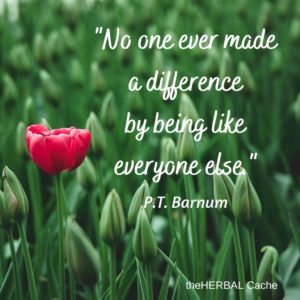
The answer is simple: be myself!
I can do this by being confident in who I am, being true to my values, and by sharing my knowledge with others.
Being confident in who I am is the foundation for everything else. If I don’t believe in myself, no one else will. So it’s important that I nurture a strong sense of self-worth. This doesn’t mean being egotistical or self-centered. It means having a healthy respect for myself and my abilities.
Being true to my values is also important. I need to stay true to what I believe in, even if it goes against the grain. If I’m not authentic, people will see right through me.
Finally, I need to share my knowledge with others. If I keep everything to myself, what’s the point? It’s important that I share my expertise with those who are interested. That way, I can make a difference in the herbal world.
Be different. Be unique.
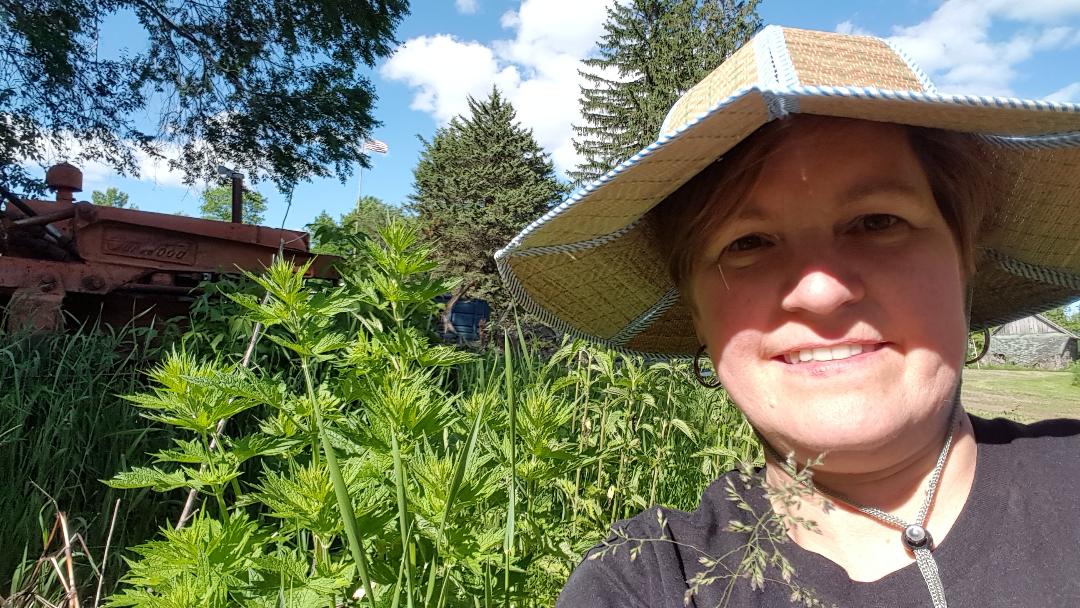
Herbalism has really gained momentum over the past few years, with more and more people looking to nature for wellness.
So where does that put me as an herbalist?
Lost! LOL!
Recently, I have started to feel like I’m swimming in an ocean, and have no sense of direction. I’m focusing on this, and then I’m focusing on that. For an entrepreneur, that is not good.
But I want to learn everything about herbalism and all there is to know about plants!
Well, I know I can keep learning. But if I want to grow my herbal business, I need a plan. I need some form of direction so my customers, like you, know what the heck I’m offering them.
My first path I want to create will be focused on herbal beverages and cocktails.
I recently read a tidbit in an email from CommonWealth Herbs on infusing herbs in wine. That caught my eye, because I love wine. So I tried it.
After that, herbs and beverages just kept popping out at me. A botanical drinks course, books, recipes, etc. And so I thought, why don’t I focus on herbal beverages? This is an easy and wonderful way to add herbs to your diet.
After all, what could be more refreshing than a nice cold herbal tea on a hot summer day? Or a delicious cocktail made with fresh herbs?
There are many types of beverages I will be looking into. Some of those will be mead, wine, infusions, shrubs, tonics, switchels, ciders and more!
As I go along on my herbal journey, I will be sharing it with you too, so that you can take part in the wonderful world of herbal drinks and add them to your wellness cabinet.
Cheers!

As with anything, the government likes to dip its hand into herbalism when it sees fit.
Don’t get me wrong, we need laws and guidelines to keep things in order. Herbalism is such a large part of our lives and it’s important to be informed about the laws and guidelines that surround it. But sometimes I feel the government takes on more then what it should.
So with this being said, with this pathway, I want to look at the history of herbalism and Big Pharma, and how they have competed throughout the years. I also will look at the current standings and bills trying to get through the legislature that involve the future of herbalism and supplements.
After all, we are the ones who use these products and we should have a say in how they are regulated.
I may only be one person, but I have to do what I can as an individual to keep herbalism safe and alive. And that means being aware of what is happening at the government level as well as what is happening in my backyard.

So my two focuses for the future are herbal beverages and the laws that affect herbalism. I don’t know how long this journey will be, but I know it will be interesting and thirst satisfying!
I will still be inserting other topics in here and there. Need to keep things interesting, right?
So I hope you will stick around for the journey.
Varicose veins are a common problem, affecting an estimated 25% of the population. While there are many treatments available, including surgery and compression stockings, some people prefer to try natural remedies first. In this blog, I will share 12 blog posts and articles discussing the benefits of using herbs to treat varicose veins and what those herbs are.
Varicose veins are veins that have become enlarged and twisted. They can be painful and unattractive. While varicose veins used to be treated with surgery, there are now a number of non-surgical treatment options available. One popular option is herbal support. Herbs can help to improve the function of the veins, reduce swelling and pain, and promote healing.
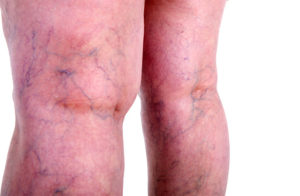
Herbs have been used for centuries to treat a variety of medical conditions, and varicose veins are no exception.
There are many different herbs that can be used to treat varicose veins, each with its own unique set of benefits.
Herbs offer a natural and affordable way to treat varicose veins. Some of the key benefits of using herbs include:
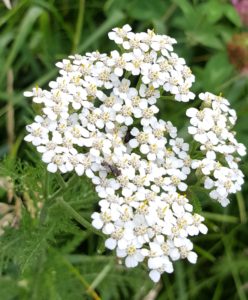
Herbs offer a safe and effective way to treat varicose veins, and I hope this blog post has provided a few ideas for you to start with.
Remember, an herb that works for one person, may not necessarily work for you. Experiment and try them, one at a time to see where you have the best results.
Exercise, diet and sleep also play a role, so don’t forget about them.
I make and sell a natural varicose vein cream that has helped a number of my customers over the years and it is my number one seller.
I grow, forage and wildcraft the yarrow and calendula that I use. The other ingredients I get from reputable sources, such as Mountain Rose Herbs.
If you are ready to combat your varicose veins, you can purchase it HERE.
Here is what one of my customers had to say:
I have to say my expectations were low when I purchased this, because I suffer from spider veins (not varicose veins) and based on my research, the only remedy was sclerotherapy, a costly procedure. I bought 2 small jars (at a great price btw) with nothing to lose. The first couple of weeks, I did not think it was working. Some days the spider veins looked a little faded, other days, unchanged. About 3-4 weeks into applying the cream 2x a day, my spider veins are nearly INVISIBLE!!! I’m genuinely mind blown. I feel so great knowing I won’t be self conscious wearing short shorts and exposing my spider vein-free thunder thighs to the world. About to purchase some more because I don’t wanna run out of this stuff. A 2 oz jar lasted me 4-5 weeks of 2x day application. If you have spider veins, definitely give this a try!
Gardening is such a relaxing and fun activity, and the whole family can join in. The best thing about gardening is that you get to reap the food benefits at the end!
If you’re interested in having a medicinal garden that is low-maintenance, there are certain things you should keep in mind to make it succeed. This includes when to plant, what plants to choose and where to put them. So be prepared to do a little research for your area.
Also, with all the chaos going on in today’s world, now is the perfect time to grow your own and not have to rely on others. Especially with the prediction of shortages looming over our heads.
Medicinal gardens provide many benefits. Not only do they look beautiful, but they can also be used to create natural remedies and food.
And don’t worry about space. Even if all you have is a balcony or small patio, you can utilize pots to grow your herbs in.
Don’t take on too much at the beginning. If you are new to gardening, maybe start with 1-4 plants and see how you do, and how the plants do. The last thing you want to do id overwork yourself and get frustrated and quit.
If you’re interested in starting your own medicinal garden, keep on reading for everything you need to know.
“The kiss of the sun for pardon,
The song of the birds for mirth
One is nearer God’s Heart in a garden
Than anywhere else on Earth.”
Many people enjoy planting medicinal herbs and other medicinal plants. The benefits of these plants have been known for centuries, and they continue to be used by many cultures around the world.
While the exact time to start planting will vary depending on the plant and the climate, there are a few general guidelines that can be followed. For most medicinal plants, it is best to start planting in early spring. This gives the plant time to become established before the hot summer months. However, some plants, such as lavender, do better if they are planted in late summer or early fall.
Think about how you want to start out. Do you want to try growing your herbs from seed or buy seedlings? Some herbs are very hard to start with seeds, so research before buying.
Many herbs are perennials, meaning they will come up every year, so once you get them started, you won’t have to replant them. One less thing to do next year!
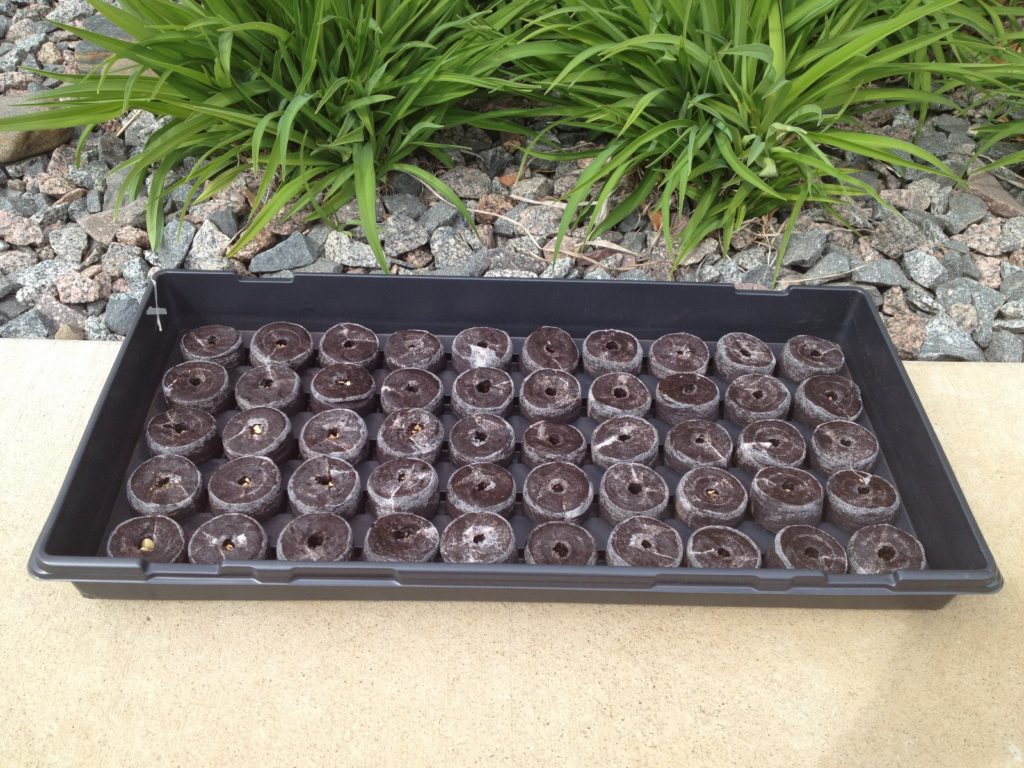
When it comes to medicinal plants, there are a variety of different options to choose from.
Some popular choices include herbs such as basil, rosemary, and mint. These herbs can be used to add flavor to food or brew tea. Other medicinal plants include echinacea, which is used to boost the immune system, and ginkgo biloba, which is often taken as a supplement to improve cognitive function.
Determine what and how you plan to use the herbs. Do you want to just use them in cooking? Than look into planting culinary herbs, such as thyme and sage. If you plan on using them for strictly medicinal purposes, what medicinal issues? If you have skin issues, you may want to plant calendula, which is wonderful for healing wounds, rashes, burns, and dry skin.
No matter what medicinal plants you choose to grow, it is important to research how to care for them properly. Make sure you know how much sun, water and space they will need, as well as any other special requirements.
With a little bit of care, your medicinal garden will grow and produce healthy plants.
Excited about the idea of growing your own medicinal plants and herbs, but not sure where to start? If you’re looking for a spot that is low maintenance and will allow your plants to thrive, here are a few ideas to get you started.
One option is to create a medicinal garden in containers. This can be an easy way to get started, and it gives you the flexibility to move your plants around if necessary. Make sure to choose containers that are large enough for the roots of your plants, and place them in an area that gets plenty of sunlight. You’ll also want to be sure to water your plants regularly, as they can dry out quickly in containers.
Another option is to plant your medicinal garden directly in the ground. If you choose this option, make sure to pick an area of your yard that gets plenty of sunlight and has well-draining soil. To prepare the soil, mix in some compost or other organic matter to help the plants thrive. Once you’ve chosen a spot and prepared the soil, you can start planting your medicinal garden.
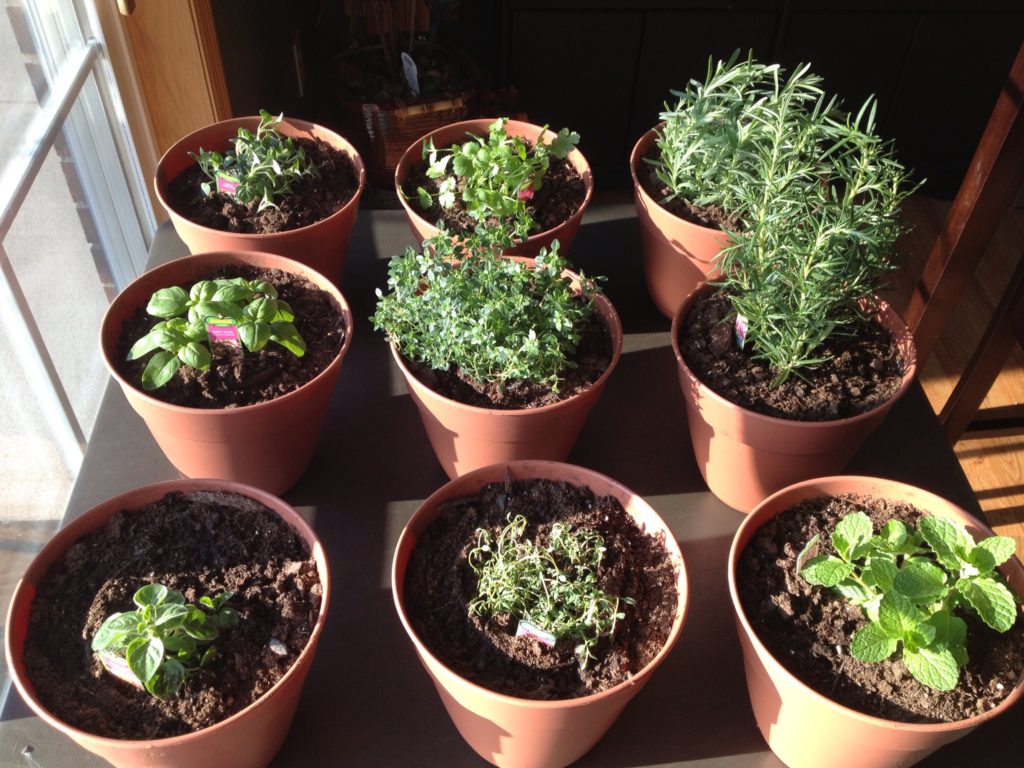
When it comes to medicinal plants and herbs, there are a few things you can do to ensure they thrive in their environment.
First, make sure they have plenty of sunlight. Most medicinal plants and herbs need at least 6-8 hours of direct sunlight each day. Secondly, water them regularly. Allow the soil to dry out slightly between watering, but don’t let the plants get too dehydrated. Third, make sure they’re in a location with good air circulation. Avoid placing them in overly humid or damp areas, as this can lead to fungal growth. Finally, don’t forget to fertilize your plants every few weeks. This will help them to continue growing strong and healthy.
Don’t get upset if a herb or two die on you. Depending on the time of year, you can always plant it again. I love a quote by the Farmstead Lady: “Well, that’s why God invented next year”! Don’t give up on the first try.
If you stay on top of it, you can help your medicinal plants and herbs stay healthy and thrive.
While many medicinal plants are herbs, there are also medicinal flowers and trees.
If you’re looking to add more medicinal plants to your garden, there are a few things to consider. First, what do you want to use the medicinal plants for? There are many different types of medicinal plants, each with their own unique properties. Do some research to find out which plants would be best suited for your needs. Second, consider which plants would be low maintenance. Some medicinal plants can be quite finicky, so it’s important to choose ones that will be easy to care for. Finally, think about how you can add variety to your garden. Maybe you could add some herbs or flowers that can also be used medicinally.
If you’re interested in adding more variety to your medicinal garden, consider some of the following low-maintenance options.
One easy-to-grow medicinal plant is lavender. Lavender has a long history of use as a medicinal herb, and it can be used fresh or dried. Lavender is most commonly used to ease anxiety and promote relaxation, but it can also be helpful for headaches, insomnia, and stomach upset.
Chamomile is another easy-to-grow medicinal plant. Chamomile tea is well-known for its ability to soothe nerves and promote sleep. Chamomile can also be used as a topical treatment for skin conditions like eczema and psoriasis.
Rosemary is a versatile medicinal herb that can be used in cooking or taken as a supplement. Rosemary is thought to improve memory and concentration, and it has also been traditionally used to treat stomach upset and headaches.
Mint is a refreshing medicinal plant that can be used in teas, salads, or as a garnish. Mint is known for its ability to soothe an upset stomach, but it can also be helpful for respiratory problems and headaches. One thing to keep in mind with any member of the mint family, is that they will take over ground space. If this is an issue, consider planting mint in a pot.
Spiraea Herbs has a wonderful video showing some perennial herbs that you can add to your garden.
These are just a few of the many medicinal plants and herbs that you can grow in your garden. By adding a few of these low-maintenance options, you can create a medicinal garden that is both beautiful and functional.
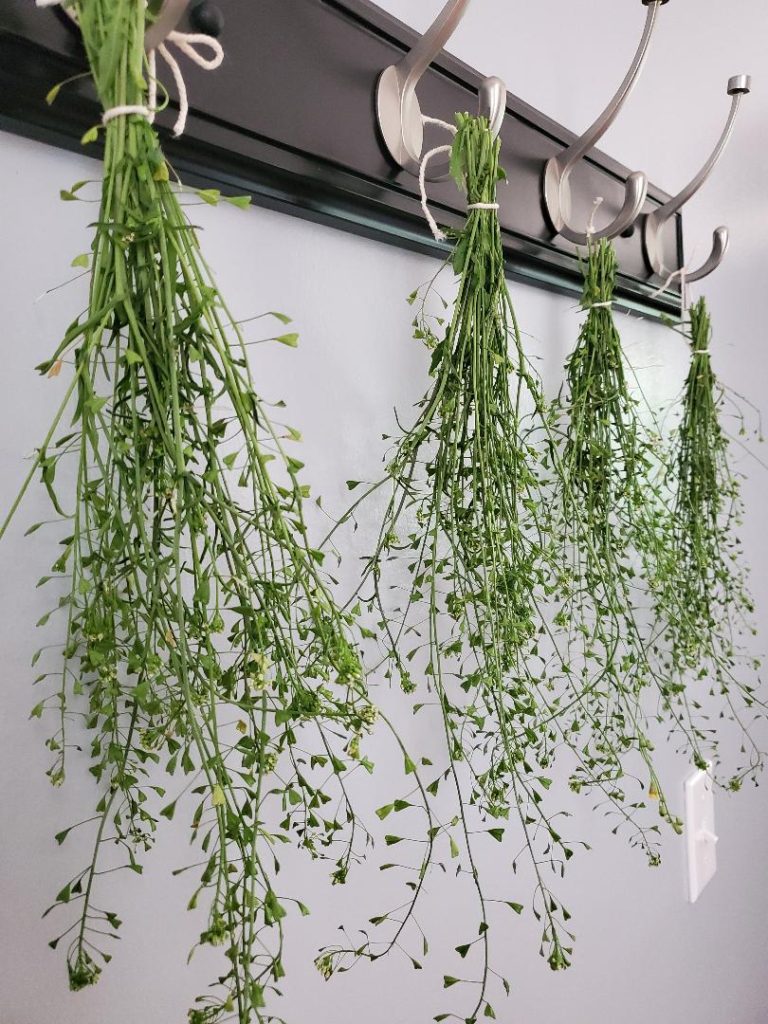
When it comes to medicinal plants, it’s important to know when to harvest them and how to store them properly. Otherwise, they may lose their potency or go bad before you have a chance to use them. Here are a few tips to help you get the most out of your medicinal plants:
With these tips, you can ensure that your medicinal plants are fresh and potent when you need them.
I hope this has inspired you to either start or add medicinal herbs to your garden.
There are many different types of medicinal plants, each with their own unique properties. Do some research to find out which plants would be best suited for your needs.
Second, consider which plants would be low maintenance and survive in your neck of the woods. Some medicinal plants can be quite finicky, so it’s important to choose ones that will be easy to care for. A plant that is easy to grow in California, may need a lot of attention in Minnesota.
Finally, take some time to learn about harvesting and storing medicinal plants. By following these tips, you can create a medicinal garden that is both beautiful and functional.
What medicinal herb are you going to plant?
If you are wondering where to get quality herbal seeds, Mountain Rose Herbs is the place to check out.
I’ve been getting herbs from them for years and trust them for high quality and ethically sourced ingredients. Their botanicals are analyzed and tested for identity, microbial, chemical, and physical contaminants.
Start shopping for your herbal seeds now!
Garden Lover
Here is a fun video to help get you in the mood!
Elderberries have been all the craze for some time. People make syrup, jam, tea and more with these berries.
What I found out in researching elderberries, was that these berries are very special. They are like the secret remedy for colds and the flu!
There are a few types of elderberry plants, but the black elderberry, Sambucus canadensis, is favored. Because of its strong anti-viral properties, it a huge defender against colds and the flu. Thus the reason for being so popular in the fall.
The world is a nettle; disturb it, it stings. Grasp it firmly, it stings not.
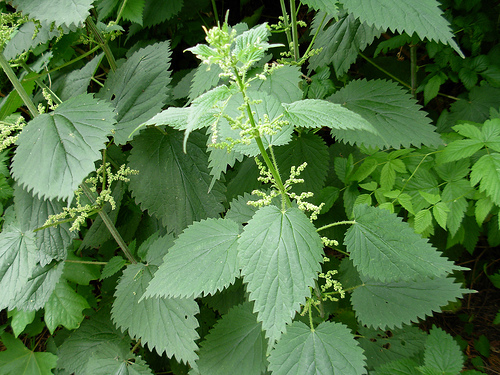
Stinging nettle has been used for centuries to treat various maladies, including anemia, arthritis and skin diseases. Its leaves are edible in salads or cooked like spinach.
And yet many people see it as a weed and want to pull it up by its roots to eradicate it.
But the benefits of stinging nettle include supporting urination, increasing blood flow and reducing neural inflammation.
Let me show you that this plant is more than just a weed.
Stinging nettle is generally considered a weed and can be found growing wild in woodlands and on river banks. It also prefers disturbed soils, such as on farmsteads, manure piles or near abandoned buildings.
Stinging nettles have long fleshy roots that can grow deep into the ground. This is important, because this is how the plant becomes so nutritious, by pulling up vitamins and minerals deep in the soil.
The leaves, stems and roots are covered in tiny hairs that release histamine and other chemicals that can sting painfully. These chemicals cause an itchy, irritating sensation on the skin which only lasts about 15 minutes.
Growing up, my mother called this plant “itch weed”, because it made you itch. So I highly recommended that you wear gloves when handling this plant. Or if you want to get the true feeling of stinging nettle, don’t.
This plant is a very fast grower and spreads easily by seed or underground shoots.
For optimal nutrition and medicinal properties, it should be picked before flowers appear. I like to harvest the tops in early spring when the plants are still young. They will grow back, so you can get a number of pickings.
Susun Weed says to grasp it by a top leaf and cut just the very top (no more than 8 leaves) and put that in the foraging basket. Since nettles are so fibrous, she says to only pick the very tops. If the scissors have difficulty cutting, it’s too far down.
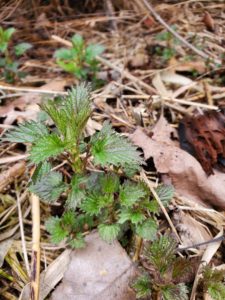
The leaves and young shoots of stinging nettle are edible. They have a slightly bitter, nutty flavor that most find pleasant. Nettle leaves can be a simple substitute for spinach in any dish.
Nettles are rich in vitamins A, C, D and K as well as iron, potassium, calcium and manganese.
One serving of stinging nettle provides almost all of the recommended daily allowance for vitamin K per day.
Nettles are also rich in chlorophyll, which gives them their green color and may be responsible for some of its health benefits.
Two studies published in the “Journal of Agricultural and Food Chemistry” evaluated the antioxidant activity of nettle extract and found it to be higher than other popular drinks like cranberry juice, grape juice and green tea. The researchers concluded that the high antioxidant activity may be due to nettle’s chlorophyll content.
The leaves are said to have a beneficial effect on the urinary system because they contain high amounts of potassium, calcium and magnesium. They also can help reduce inflammation in the bladder lining which may prevent chronic infections from developing.
In addition to its nutritional value, some studies suggest that stinging nettle may also have medicinal properties.
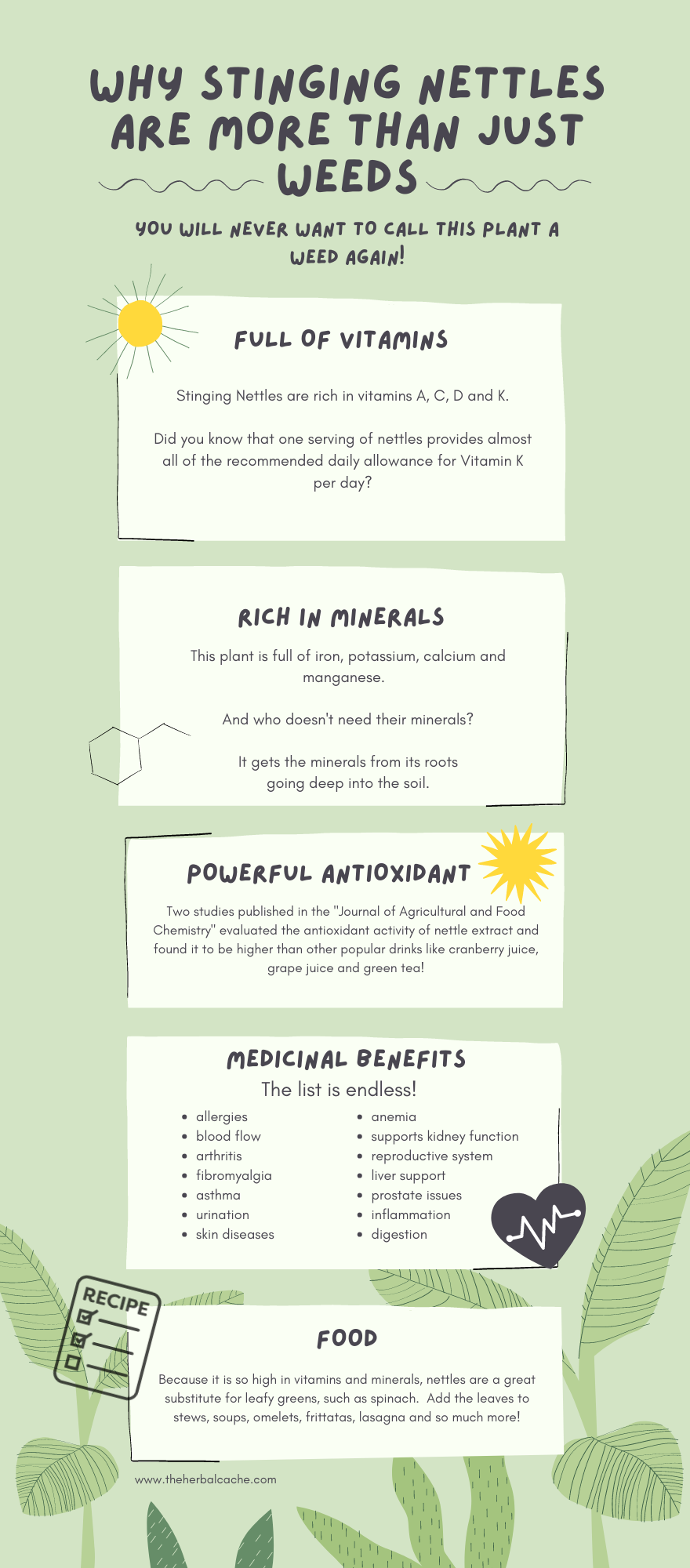
In addition to its nutritional content, stinging nettle is said to have medicinal properties. Its roots and leaves are used in traditional herbal remedies for conditions such as anemia, arthritis and skin diseases. In addition, modern uses include supporting urination and increasing blood flow. Nettle root may also help relieve symptoms of the common cold.
One small study published in the “Journal of Complementary and Alternative Medicine” found that patients who suffered from frequent colds showed a significant decrease in number of colds after taking nettle root extract daily for 12 weeks. These results were not found with the placebo group.
Another study conducted by researchers at the University of Virginia found that drinking stinging nettle tea reduced the total number of colds by more than one-third among patients who suffered from chronic respiratory infections.
Brigitte Mars talks about how people have used nettles for thousands of years to help with pain from arthritis, fibromyalgia and as an early substitute for Viagra! By gently brushing a stem of leaves over one’s skin, the irritation causes a huge blood flow to the area (called irtication). Thus helping with pain, inflammation, etc.
Nettle is a wonderful herb for those with allergies. A study published in “Alternative Therapies in Health and Medicine” suggested that an extract from this plant may reduce inflammatory responses due to allergies, which suggests it may be effective in relieving symptoms of allergies and asthma.
Herbalist Matthew Wood says the seeds in particular, may help get rid of allergies, both food allergies and seasonal ones. He also recommends the root be taken for prostate problems.
Stinging nettle also helps get rid of mucus in the lungs.
David Hoffman calls this plant the “ultimate green tonic”. That should tell you something.
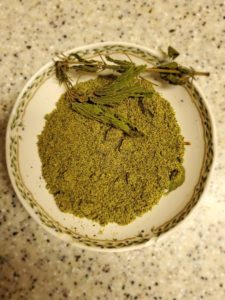
There are a number of ways you can incorporate stinging nettle into your diet.
A very easy way is to cook it like spinach or added to soups and stews for extra nutritional benefit. Herbalist Rosemary Gladstar likes to saute it with a little olive oil, lemon juice and feta cheese.
Herbal Revolution preserves their nettles like this to to enjoy all year:
These little “patties” can be added to soup, pesto, sautéed, in frittata, scrambled eggs, smoothies, etc. This could also be done with dandelion greens!
The young shoots may also be eaten fresh or steamed. But make sure to get the tops of young plants. Nettles are very fibrous in older plants and growth near the ground.
To make stinging nettle tea, steep one teaspoon of dried herb for eight to 10 minutes in hot water. This makes an excellent substitute for coffee that is high in antioxidants and many other nutrients.
People who suffer from chronic conditions like allergies and arthritis may find relief by drinking stinging nettle tea.
Taking nettle in a tincture form is available if you can’t stomach eating the greens, or don’t like drinking teas. As a tincture, it is a more concentrated and you can take it as needed. You can find tinctures in most natural food or wellness stores.
Making a herbal decoction with nettles is another great way to take this plant. Just follow these simple instructions:
My favorite way to use nettles is by making Nettle Gomasio! This herbal spice blend can be used on almost everything. I personally like it on my fried eggs and popcorn.
In the video below, I show you just how easy it is to make your own Nettle Gomasio!
I hope I have shown you just how beneficial stinging nettles are for us.
Not only are they nutritious in terms of the vitamins and minerals they provide, but they also help support our health and body in a number of ways.
Nettles have been around for thousands of years, and I hope they will be around for a thousand more. Because we need them.
So go and “nettle” up!